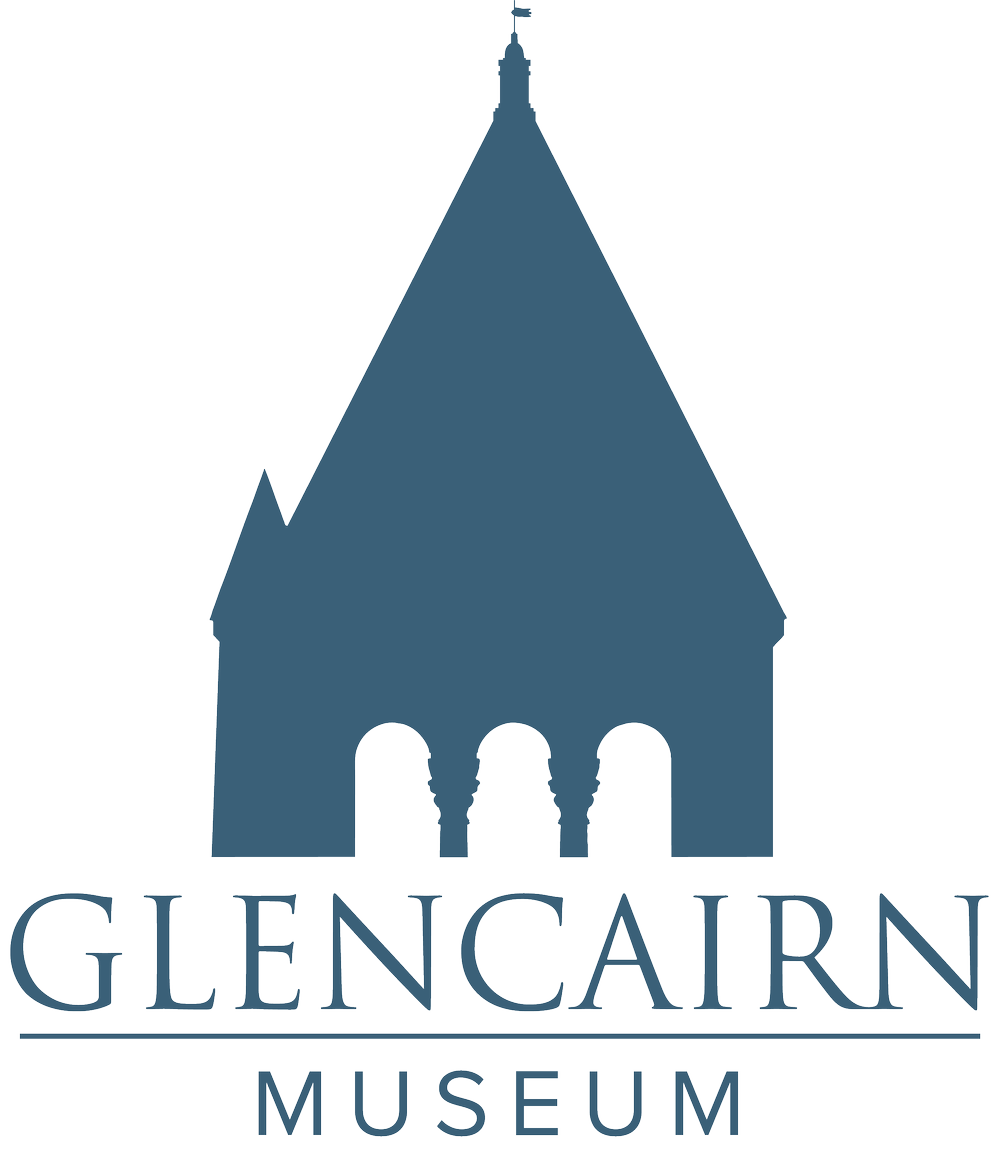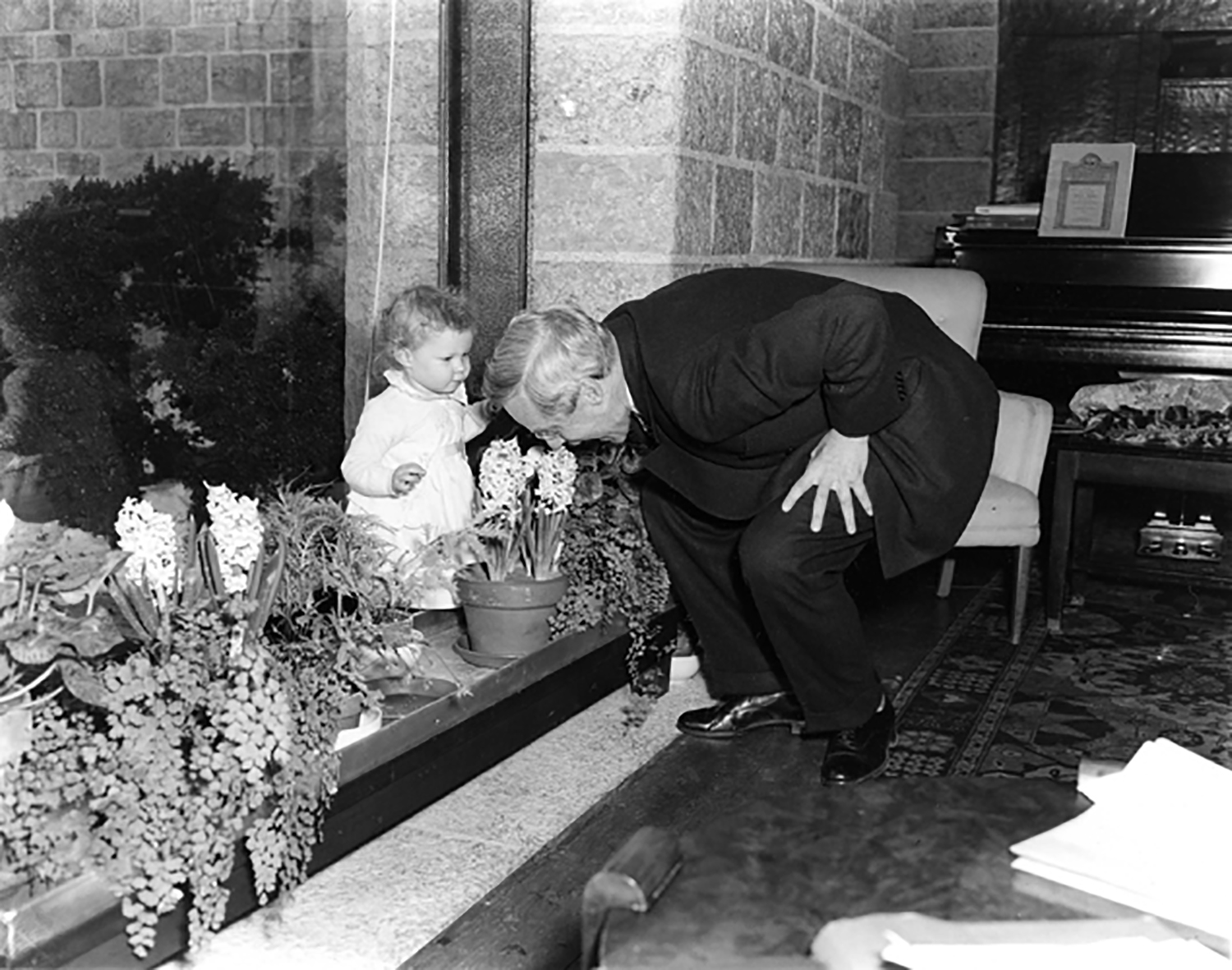Glencairn Museum News | Number 2, 2016
Winfred S. Hyatt Last Supper scene.
Figure 1: Raymond Pitcairn smells a hyacinth, while one of his granddaughters looks on, circa early 1960s.
The Winfred S. Hyatt Easter scenes were originally made in the 1920s for Cairnwood, Raymond’s childhood home, where the Pitcairn family resided until Glencairn was completed in 1939. The scenes continued to be displayed annually after the move to Glencairn, and soon became part of an Easter tradition enjoyed by the Pitcairn grandchildren. The grandchildren fondly remember coming to Glencairn to see the scenes with their parents each year, and picking out a flower to take to Bryn Athyn Cathedral on Easter Sunday (grown in the Pitcairns’ nursery). At Glencairn they also received a family Easter basket to take home.
The Easter story is told in all four Gospels of the New Testament. The narrative involves tremendous sadness, followed by great joy. Some of the major episodes in the Easter story are 1) Christ’s celebration of a meal with His twelve disciples, known as the Last Supper, 2) His trial and then His crucifixion, known as Good Friday, 3) His resurrection on Easter Sunday, 4) and, finally, His ascension into heaven.
In addition to the three-dimensional Last Supper scene made by Winfred Hyatt, visitors on the “Easter Art at Glencairn” tour will be introduced to a panel of thirteenth-century stained glass that most likely depicts the Last Supper (Figure 2). The panel features Christ in the center, with four disciples on the left and two on the right. (At some point this was probably cut down from its original size, and would originally have had more figures.)
Figure 2: Thirteenth-century stained-glass panel from France, most likely depicting the Last Supper. Glencairn Museum, 03.SG.108.
Figure 3: Detail from the Last Supper scene designed by Winfred Hyatt for the Pitcairn family in the 1920s.
In Glencairn’s Great Hall, a fifteenth-century stone statue represents Jesus Christ during His appearance before Pontius Pilate, the Roman official who ordered His crucifixion (Figure 4). Christ wears a robe and a crown of thorns, placed on Him by Roman soldiers after they had whipped Him. This was done to mock the claim that He was “King of the Jews.” The facial expression of Jesus is one of suffering and grief. This type of statue represents a specific moment from the New Testament’s Gospel of John (19:5), referred to as the Ecce Homo (“behold the man”): “Then Jesus came out, wearing the crown of thorns and the purple robe. And Pilate said to them, ‘Behold the Man!’”
Figure 4: Fifteenth-century stone statue representing Jesus Christ during His appearance before Pontius Pilate. This style of statue is referred to as Ecce Homo ("behold the man"), taken from the New Testament Gospel of John (19:5). Glencairn Museum, 09.SP.86.
Glencairn’s Medieval Gallery includes an impressive collection of stained-glass panels, several of which are featured on the “Easter Art in Glencairn” tour. One thirteenth-century panel from France depicts the Crucifixion (Figure 5). Christ on the cross is flanked by Mary, His mother, on the left, and John the Apostle on the right. John holds a book, while Mary reaches out her hands in an agonized gesture, as if she is trying to save her son. John rests his head in his hand, a convention used in medieval art to express grief. Personifications of the sun and the moon can be seen above the scene, emphasizing the Christian idea of the cosmic implications of the Crucifixion for all of creation.
Figure 5: Thirteenth-century stained-glass panel from France depicting the Crucifixion. Glencairn Museum, 03.SG.221.
Following Christ’s crucifixion, He was placed in a tomb provided by Joseph of Arimathea. Two of the Hyatt Easter scenes portray biblical events that occurred after His resurrection, when the tomb was empty. In one scene, taken from the account found in the Gospel of Matthew (28:1–8), Mary Magdalene and a woman referred to as “the other Mary” come to visit Christ’s tomb on Sunday morning (Figure 6). An earthquake occurs when an angel rolls back the stone blocking the entrance. The Roman guards are so afraid that they become “like dead men.” The two women are told by the angel not to be afraid, for Christ “has risen.” They are invited to see where His body had lain, and further instructed to go and tell the disciples the good news, and that Jesus will meet them at Galilee.
Figure 6: Mary Magdalene and “the other Mary” come to visit Christ’s tomb on Sunday morning and are met by an angel. This scene is part of the Winfred Hyatt Easter scenes designed for the Pitcairn family in the 1920s.
The final Hyatt scene is from the Gospel of John (21:9–14), when Jesus appeared after His resurrection to seven of the disciples by the Sea of Galilee (Figures 7 and 8). The disciples are out fishing, and do not catch anything all night. They are then told by a man on the shore to cast their net on the right side of the boat. Suddenly it is miraculously filled with fish, and they realize that the man is Jesus Christ. They come to shore, where a small fire is already waiting with fish and bread.
Figure 7: Jesus appears to seven of His disciples by the Sea of Galilee following His resurrection. This is the final scene in the Winfred Hyatt Easter scenes designed for the Pitcairn family in the 1920s.
Figure 8: Detail from the Winfred Hyatt Easter scenes of Jesus speaking to His disciples by the Sea of Galilee.
The oldest example of medieval Easter art shown on the tour is a twelfth-century French capital (Figure 9). Raymond Pitcairn incorporated this sculpture into the design of Glencairn’s Great Hall, atop a column on the right side of the main fireplace. It depicts the moment of Christ’s ascension to heaven. Christ is shown in the center, His arms stretched upward. He is supported on either side by angels with halos in flight.
Figure 9: Twelfth-century French stone capital depicting the Ascension in Glencairn’s Great Hall. Glencairn Museum, 09.SP.115.
Figure 10: Sixteenth-century French stained-glass panel with the head of Christ. Glencairn Museum, 03.SG.9.
The Winfred Hyatt Easter scenes can be viewed at Glencairn on weekends from 1:00 until 4:30 pm. The “Easter Art in Glencairn” tour is available on weekends, or by appointment during the week, until March 26th, 2016. For more information click here.
(KHG/CEG)
A complete archive of past issues of Glencairn Museum News is available online here.











